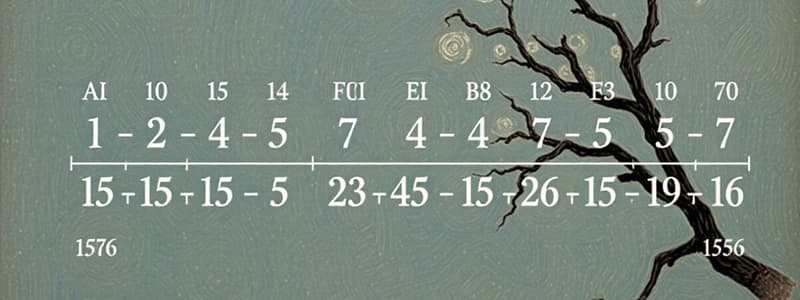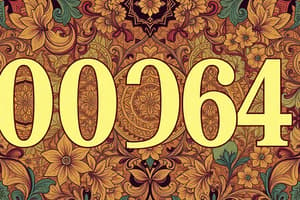Podcast
Questions and Answers
Which of the following is a base 8 number system?
Which of the following is a base 8 number system?
- Binary number system
- Hexadecimal number system
- Octal number system (correct)
- Decimal number system
What is the base of the decimal number system?
What is the base of the decimal number system?
- 10 (correct)
- 2
- 16
- 8
What advantage does the octal number system have over other systems?
What advantage does the octal number system have over other systems?
- It is based on powers of 16.
- It allows for larger numbers.
- It can represent more values per digit.
- It has fewer digits, reducing computational errors. (correct)
In which number system does the digit '3' represent the same value as in the decimal system?
In which number system does the digit '3' represent the same value as in the decimal system?
How do you convert the binary number (100111)2 into the decimal system?
How do you convert the binary number (100111)2 into the decimal system?
What is the sum of the decimal equivalents when converting the binary number (100111)2?
What is the sum of the decimal equivalents when converting the binary number (100111)2?
Which digits are used in the hexadecimal number system?
Which digits are used in the hexadecimal number system?
Which statement about number systems is incorrect?
Which statement about number systems is incorrect?
Flashcards are hidden until you start studying
Study Notes
Number Systems
- A number system represents numbers using digits or symbols consistently.
- The digit's value depends on position and base.
- Different number systems are used to represent numbers, the primary types are Binary, Decimal, Octal, and Hexadecimal.
Octal Number System
- Uses digits 0 to 7 (base 8).
- It's advantageous due to fewer digits compared to other systems like Binary, potentially reducing calculation errors.
- Examples: 358, 9238, 14183588.
Decimal Number System
- Uses digits 0 to 9 (base 10).
- It's the system commonly used in daily life.
- If a number has no specified base, it's assumed to be decimal (base 10).
- Examples: 72310, 524710, 3210, 983710.
Conversion from Binary to Decimal
- To convert a binary (base 2) number to decimal (base 10):
- Multiply each digit of the binary number, starting from the rightmost, with increasing powers of 2 (2^0, 2^1, 2^2, and so on).
- Add the results of these multiplications.
- Example 1: Convert (100111)2 to decimal
- (1 x 2^5) + (0 x 2^4) + (0 x 2^3) + (1 x 2^2) + (1 x 2^1) + (1 x 2^0) = 32 + 0 + 0 + 4 + 2 + 1 = 39
- Example 2: Convert (111111)2 to decimal
- (1 x 2^5) + (1 x 2^4) + (1 x 2^3) + (1 x 2^2) + (1 x 2^1) + (1 x 2^0) = 32 + 16 + 8 + 4 + 2 + 1 = 63
Studying That Suits You
Use AI to generate personalized quizzes and flashcards to suit your learning preferences.




